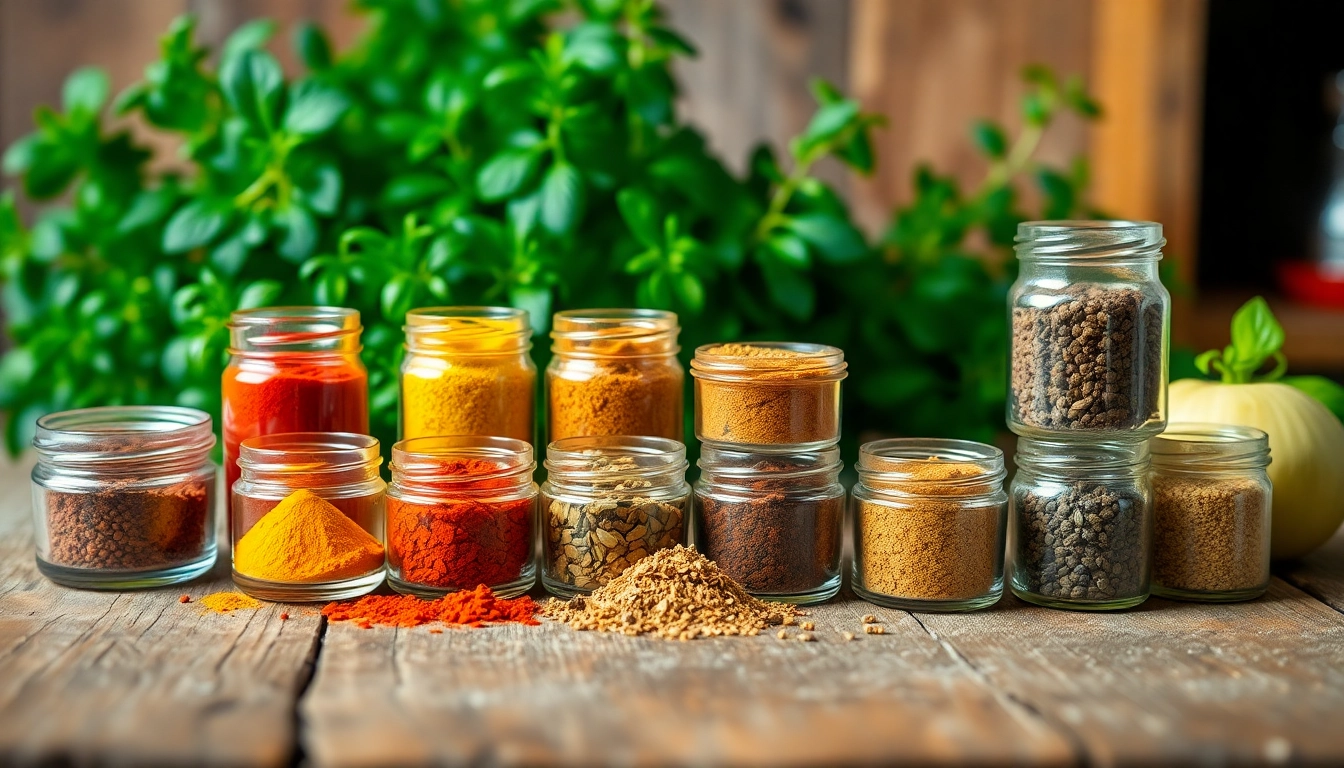
Why Single Origin Spices Revolutionize Your Culinary Experience
Understanding Single Origin Spices
What are Single Origin Spices?
Single origin spices are those that are sourced from a specific geographic region, often from a particular farm or community of farmers. This locality gives these spices a distinct character, flavor profile, and identity—much like how wine reflects its terroir. Each single-origin spice encapsulates the culture, soil, and climate where it is grown, resulting in vibrant flavors that can transform the culinary landscape of any dish.
Unlike blended spices that may mix various origins to achieve a uniform flavor, single origin spices celebrate authenticity by highlighting unique characteristics tied to their place of origin. For culinary enthusiasts and professional chefs alike, this diversity offers an expansive palette of flavors and aromas that can elevate everyday meals into extraordinary experiences. For more insights and further exploration, consider checking out various Single Origin Spices available online.
The Importance of Sourcing
Sourcing plays a vital role in the quality and authenticity of single origin spices. Ethical sourcing practices ensure that farmers receive fair compensation for their labor and products, creating a sustainable supply chain. This is particularly crucial in regions where spice cultivation is a primary source of income for families.
Many brands, such as Burlap & Barrel and Curio Spice Company, emphasize direct partnerships with farmers from specific regions. This not only guarantees fresher products but also fosters a relationship between the grower and the consumer, leading to greater transparency in food sourcing. Knowing where your spices come from, and the methods used to produce them, can enhance appreciation for the culinary ingredients and their role in cuisine.
How Terroir Affects Flavor
Terroir refers to the unique environmental conditions, such as climate, soil type, and farming practices, that influence the character of agricultural products, including spices. Each region’s specific blend of these factors directly affects the growth and sensory profile of spices. For instance, the same variety of chili grown in different regions can yield drastically different heat levels and flavors.
The concept of terroir is essential when evaluating single origin spices. Take vanilla as an example: Madagascar vanilla is renowned for its creamy and sweet aroma that differs significantly from vanilla grown in Mexico, which may have hints of smoke and earthiness. Understanding these nuances enhances a chef’s ability to select the right spices for a dish, ensuring that the final product is balanced and rich in flavor. This not only improves personal satisfaction in cooking but is also a gatekeeper to a culinary adventure.
Choosing the Best Single Origin Spices
Identifying Quality and Authenticity
Selecting high-quality single origin spices requires a discerning eye. Authenticity can often be verified through specific indicators such as packaging, provenance information, and certifications (like organic or fair trade). Reputable brands typically provide transparency on how their spices are sourced, the farming communities they support, and even the method of cultivation.
Online reviews and feedback from fellow cooks can also guide your choices. Engaging with spice communities on social media or culinary forums can yield helpful insights into where to find the best single-origin spices. Furthermore, tasting is key; always try to sample spices before purchasing larger quantities. Fresh, vibrant spices should have a strong aroma and a bright flavor when tasted.
Top Sources for Premium Spices
There are numerous desirable sources for premium single origin spices across the globe. From the fiery chilies of India to the exotic peppercorns of Java, the variety is boundless. Several standout brands are recognized for their dedication to quality:
- Burlap & Barrel: Famous for sourcing spices directly from farmers, this brand ensures that every product is both flavorful and ethically produced.
- Curio Spice Company: This brand focuses on traceable spices that are vibrant and packed with culinary integrity, often highlighting unique growing conditions.
- Diaspora Co.: Specializing in single-origin spices from regenerative farms in India and Sri Lanka, they offer a refined flavor that appeals to discerning cooks.
Additionally, exploring local farmers’ markets or specialty grocery stores can reveal hidden gems of single origin spices that might not be as widely available or promoted online.
Seasonality and Availability
The availability of single origin spices can often depend on the seasons and harvest cycles, making it important for cooks to know when certain spices are at their peak freshness. Spices like saffron and cardamom, for example, are usually harvested at specific times of the year, and their quality can vary significantly based on when they are picked and processed.
Following seasonal guides and subscribing to newsletters from your favorite spice vendors can keep you informed about the best times to buy specific spices. Additionally, understanding how to utilize dried versus fresh spices in accordance with their seasons will enhance your culinary creations. For instance, fresh herbs might have a stronger flavor and aroma when they are in peak growing season and should be used as such.
Cooking with Single Origin Spices
Enhancing Dishes with Unique Flavors
Single origin spices can dramatically enhance the sensory profile of dishes. By focusing on the specific flavor characteristics of each spice, cooks can create layered, complex flavor profiles that transcend basic seasoning. Using spices thoughtfully can elevate a dish—take a simple roasted chicken, for instance. By adding smoked paprika from Spain, freshly ground cumin from Egypt, and coriander from India, you can transform it into something far more aromatic and flavorful.
Incorporating single origin spices also encourages creativity. Chefs can experiment with themed spice blends, exploring textures and flavors that originate from different regions. For instance, a Southeast Asian dish might benefit from a mix of Thai basil, lemongrass, and chili sourced from individual farms for the utmost freshness.
Recipes Featuring Single Origin Spices
Integrating single origin spices into cooking can be as straightforward as using them to accompany timeless recipes. Here are a few suggestions:
- Indian Curry: Use turmeric, cumin, and coriander sourced from India for an authentic and aromatic dish.
- Mexican Mole Sauce: Incorporate single-origin cacao from Mexico and a variety of chiles for a rich, deep flavor.
- Aromatically Spiced Rice: Utilize cardamom and cloves from Sri Lanka, blended with a pinch of saffron.
These recipes not only highlight the spices themselves, but also celebrate the essence of their origins. The key to successfully cooking with single origin spices is to understand their flavor profiles and seasoning capabilities in harmony with one another.
Pairing Spices with Various Cuisines
Pairing single origin spices with various cuisines is about understanding the complementary flavors that will enhance your dish. For instance, Mediterranean flavors might shine with the addition of sumac or za’atar, while spices like garam masala are quintessential in Indian cuisine.
Exploring international dishes provides an exciting avenue to experiment with single origin spices. Say you’re cooking a Persian dish; spices like saffron and cardamom would be essential, while a Caribbean meal might benefit from allspice and nutmeg sourced from Jamaica. The key is to intertwine the spices with local ingredients, allowing for a fusion of flavors that pays homage to both their origins and culinary traditions.
Storage and Preservation Tips
How to Maintain Spice Freshness
Proper storage is essential for maintaining the freshness and potency of your single origin spices. Begin by selecting airtight containers made of glass or high-quality plastic. Exposing spices to light, heat, and moisture is detrimental to their longevity. A cool, dark cupboard works best for storage.
Additionally, consider using smaller jars for long-term storage and keep a few readily accessible jars for daily use. This way, you won’t be frequently exposing the larger quantities to air and potential spoilage. For spices like chili powder or ground pepper, consider purchasing whole spices and grinding them as needed to preserve freshness.
Best Practices for Long-term Storage
When it comes to long-term storage, consider labeling your containers with the date of purchase or expiration. While whole spices can last for several years if properly stored, ground spices typically last around six months before their flavor begins to diminish. Keeping an organized spice rack or drawer allows you to rotate your inventory effectively, using older spices first.
An additional tip is to regularly check for quality. If spices lose their aroma or flavor intensity, it’s time to consider restocking—spices should retain their vibrant scents, which are a testament to their quality.
Recognizing Signs of Spoilage
Recognizing spoilage signs in spices is crucial for maintaining culinary excellence. Common indicators include:
- Loss of Aroma: If a spice no longer emits a strong fragrance, its potency has likely diminished.
- Color Fading: Spices should maintain their vibrant colors. Dullness could signify age.
- Off Flavors or Odors: Any unpleasant or unusual scents may indicate spoilage.
Trust your senses—if a spice no longer tastes good, it’s best to replace it to ensure the quality of your dishes remains high.
The Future of Single Origin Spices
Trends in Spice Sourcing and Production
The future of single origin spices is poised for growth, driven by a demand for transparency, ethical sourcing, and sustainability. Consumers are increasingly looking for products that are not only flavorful but also support local economies and fair wages for farmers. This has prompted several brands to adopt direct sourcing practices, enhancing their connection between producers and consumers.
Technological advancements in farming methods and distribution logistics are also shaping how spices are produced and delivered, ensuring freshness and enhancing traceability. Moreover, as consumers become more educated about spices and their origins, brands are responding by offering detailed stories about their products—from the farmers who grow them to the conditions under which they thrive.
Ethical Considerations in Spice Trade
As the appreciation for single origin spices grows, so does the conversation around ethical considerations in the spice trade. Issues such as deforestation, fair trade practices, and sustainable farming methods are at the forefront of discussions within the industry. Consumers are increasingly aware of the ethical implications of their purchasing choices and are more likely to support brands that align with their values.
This has led to an increase in the popularity of organic and fair trade spices, with many companies showcasing their commitment to sustainable practices. Additionally, efforts to support biodiversity through the cultivation of heirloom varieties can help preserve local ecosystems while providing unique flavors.
Potential for Culinary Innovation
The future of single origin spices is not just rooted in tradition; it also presents immense opportunities for culinary innovation. Chefs and food producers are continually experimenting with new combinations of spices, techniques, and presentations that fuse global influences into contemporary cuisine. This trend allows for dynamic culinary exploration and creativity.
One potential area for growth is in the realm of spice-centric cuisine, where the spices themselves become the hero of the dish rather than a mere supporting ingredient. Innovative uses, such as spice-infused oils or distilled extracts, could pave the way for the next culinary revolution, encouraging not only a deeper appreciation but also inspiring new applications for single origin spices in modern cooking.
